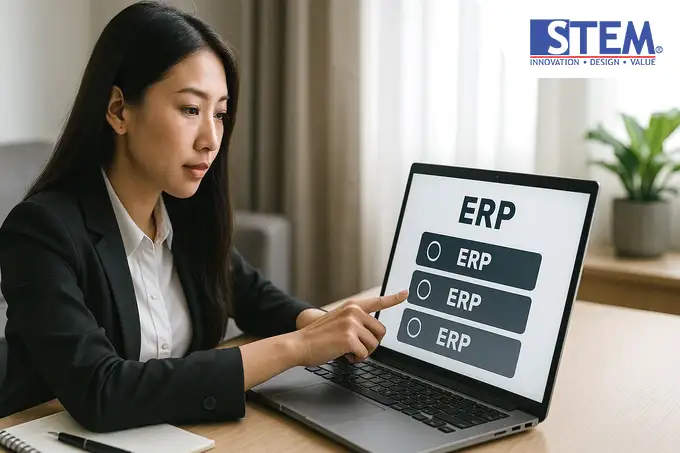Often overwhelmed by sales data scattered across Excel files, inventory records in handwritten notebooks, and financial reports generated by disparate accounting software?
Each department operates in silos, and when you need a consolidated report, it means burning the midnight oil just to copy and paste
This is a common affliction for growing businesses: the data exists, but it’s fragmented. The result? Decision-making slows down and is often guided by gut feeling rather than facts.
If you’re nodding in agreement, then it’s time to get acquainted with ERP (Enterprise Resource Planning).
Don’t be intimidated by the term. Think of ERP as the central nervous system of your business—connecting the brain (management), hands (production), feet (sales), and stomach (finance) into one cohesive, synchronized unit. All your data flows into a single, accessible, and accurate source.
This article isn’t a sales brochure. It’s a practical, step-by-step guide designed to help you choose an ERP system that truly solves problems, rather than adding to your headaches. We’ll dissect it all—clearly and without convoluted marketing jargon.
Let’s dive in.
What Is ERP Software, Really?

Forget the textbook definitions that put you to sleep.
ERP software is a single, integrated application used to manage all core business processes digitally.
Imagine juggling multiple remote controls—one for the TV, another for the AC, a third for your audio system. Exhausting, right? ERP is your universal remote: one system to manage:
- Finance: From recording purchase receipts, issuing sales invoices, managing accounts payable/receivable, to generating profit and loss statements and balance sheets—everything is meticulously tracked in one place.
- Inventory & Warehousing: Know the exact quantity of item A, B, or C in real time. Say goodbye to “I think we still have some” and the customer disappointments that follow. From purchase order to goods receipt—automated.
- Sales & CRM: Sales teams can log every customer interaction—from initial quotes to successful transactions. Management sees real-time performance without waiting for weekly reports.
- Manufacturing: For manufacturers, this module is the heartbeat—handling bill of materials, work orders, and finished goods.
- Human Resources (HRM): Manage employee records, attendance, payroll, leave requests, and performance evaluations.
Why does this matter? Because centralized data allows you to answer vital business questions instantly: “Which product sold the most this month?” “What’s our cost per unit?” “Who are our most loyal customers?” Business decisions become data-driven—not guesswork.
The ERP Selection Process

This is where theory turns into practice. The biggest mistake? Typing “Best ERP Software” into Google and calling the top-listed vendor. Don’t. That’s like building a house without blueprints.
Follow these steps methodically to avoid getting lost—or wasting money.
Step 1: Internal Audit (Understand Your Business Needs)
Before seeking external solutions, look inward. Gather your team (finance, warehouse, sales) and answer these honestly:
- What’s our biggest current pain point? Is it slow invoicing? Inaccurate stock levels? Financial reports that take weeks?
- Which processes are most manual and time-consuming? Map your current workflows. Where are the bottlenecks?
- Which critical data is hard to access for decision-making?
- Where do you see your business in 5 years? Opening new branches? Expanding product lines? Your software must support that growth (scalability).
Document everything—this will become your “cheat sheet” when talking to vendors.
Step 2: Form an ERP Project Team
Choosing ERP is not a solo or IT-only task. It’s a business-wide initiative. Form a small cross-functional team:
- Finance Representative: Knows the money flow inside out.
- Operations Representative (Warehouse/Manufacturing): Understands real-world challenges.
- Sales/Marketing Representative: Interacts with customers daily.
- IT Representative: Ensures technical feasibility and integration.
- Executive Sponsor (Owner/Director): The decision-maker who champions the project.
This team will evaluate, select, and later support implementation.
Step 3: Budget Planning (Let’s Talk Money)
ERP is an investment—not just an expense. Don’t fixate solely on software price. Understand Total Cost of Ownership (TCO):
- License Fees: One-time purchase (Perpetual) or subscription-based (Monthly/Annual).
- Implementation Costs: Often higher than the license itself—includes consultants for installation, setup, and process alignment.
- Customization Fees: If your business has unique processes, modifications will cost extra.
- Training Costs: Teaching your team to use the new system. Never underestimate this.
- Maintenance Costs: Usually 15–22% of license cost annually—for updates and support.
A full breakdown is available in our dedicated article on ERP Implementation Costs.
Step 4: Vendor Research and Shortlisting
Now it’s time to Google. Create a longlist of ERP vendors—both local and international. Then narrow it down to a shortlist of 3–5 based on:
- Industry Specialization: Do they have experience in your field (e.g., retail, manufacturing, distribution)?
- Case Studies & Testimonials: Look at their clientele—are there businesses similar to yours?
- Reputation & Reviews: Check forums and business communities.
- Local vs. Global Vendors: Local providers often understand local regulations (e.g., tax compliance), while international vendors may offer more advanced features.
We’re preparing a detailed article on Top ERP Software in Indonesia to support you here.
Step 5: Request a Demo or Trial (Don’t Buy Blindly)
Invite the shortlisted vendors for presentations and demos. But don’t just watch passively—ask them to demonstrate workflows related to your key problems (from Step 1).
Example: “Please walk us through the process—from sales quoting, goods dispatch, to invoice generation and payment settlement.”
If possible, request a trial account or proof of concept (POC) so your team can test the system.
Step 6: Check Client References
This is a crucial yet often skipped step. Ask vendors to provide 2–3 current client contacts. Speak to them and ask:
- Did the software deliver what was promised?
- How is the vendor’s support and consulting team?
- What were the biggest challenges during implementation?
Real users provide far more candid insights than any sales rep.
Other Key Considerations
Beyond the steps above, weigh these technical and strategic factors:
Scalability: Can It Grow with You?
Ensure the system can handle higher transaction volumes in the future. Ask: “What’s the max user and transaction capacity?”
Deployment: Cloud or On-Premise?
A critical decision.
- On-Premise: Buy a license and host it on your own office servers.
- Analogy: Building your own home.
- Pros: Full control over data/security.
- Cons: High upfront cost and IT maintenance needs.
- Cloud (SaaS): Rent software accessed via the internet. Vendor manages servers and upkeep.
- Analogy: Renting a fully furnished apartment.
- Pros: Low initial cost, remote access, zero server worries.
- Cons: Relies on internet and vendor stability.
For growing SMEs, Cloud ERP is often the most cost-effective choice. We’ll explore this more in our ERP Cloud vs. On-Premise comparison article.
Technical Support
When the system crashes or glitches—how quickly does the vendor respond? Do they offer local Indonesian support? What’s included in their support plan? Ensure all of this is clear in your contract.
Preparing for Implementation
Choosing and purchasing the software is only half the journey. The other half—implementation—is a project unto itself.
Here’s the typical flow post-contract:
- Project Planning: Define timelines and responsibilities.
- Data Migration: Transfer master data (products, customers, suppliers) from old systems. This is the most intricate phase.
- User Training: Educate your entire team.
- Go-Live: The system officially becomes part of your daily operations.
Success hinges on two things: clean data and change management (getting your team to embrace new workflows). A full guide is available in our article 8 Keys to ERP Implementation Success.
Conclusion: This Is a Journey, Not a One-Off Project
Choosing an ERP system is akin to choosing a life partner for your business. Don’t be swayed by discounts or persuasive sales pitches. This process demands time, research, and thoughtful self-reflection.
Remember, the best ERP isn’t the most expensive or sophisticated. The best ERP is the one that aligns perfectly with your needs, processes, and budget.
Start today with Step One: grab a notepad, gather your team, and begin your internal audit.
Good luck—and may you find the central nervous system your business truly needs.


